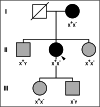From Rare to Common: Genetic Insights into TLR7 Variants in a Multicentric Spanish Study on COVID-19 Severity
- PMID: 40423910
- PMCID: PMC12116960
- DOI: 10.1007/s10875-025-01892-0
From Rare to Common: Genetic Insights into TLR7 Variants in a Multicentric Spanish Study on COVID-19 Severity
Abstract
TLR7, which encodes a key receptor for single-stranded RNA (ssRNA) virus of the innate immune system, was recently associated with X-linked immunodeficiency and COVID-19 susceptibility. This study investigates the association between TLR7 variants and susceptibility to severe COVID-19 in a multicentric Spanish cohort. The TLR7 gene was sequenced in a cohort of 365 COVID-19 patients, stratified into two groups: one comprising mild and asymptomatic patients, considered as controls (n = 87), and the other consisting of moderate to severely affected patients hospitalized due to COVID-19 pneumonia, considered as cases (n = 278). A total of 152 unique TLR7 variants were identified, of note, six rare variants were identified in 11 cases (3.96%), all of whom belonged to the case group. The functional impact of rare TLR7 variants was assessed using a luciferase reporter assay and revealed that N215S is a loss-of-function (LOF) variant, while D332G exhibits an hypomorphic behavior. Conversely, H90Y, V219I, A448V, and R902K maintained normal signaling. No skewed X-inactivation was observed in female carriers of N215S or D332G. In addition, the common variants Q11L (rs179008), c.4-151A>G (rs179009) and c.*881C>G (rs3853839) were associated with severe pneumonia, while c.4-151A>G (rs179009) was specifically linked to Intensive Care Unit (ICU) admission. These findings highlight the role of TLR7 in antiviral immune response and its association with severe COVID-19 in men. The luciferase assay proves to be a reliable tool for evaluating TLR7 signaling, effectively distinguishing between neutral, LOF, and gain-of-function (GOF) variants. Further research is needed to better understand TLR7 variants and its implications in immunodeficiency and immune dysregulation.
Keywords: COVID-19; TLR7; X-linked; immunodeficiency; innate immunity.
© 2025. The Author(s).
Conflict of interest statement
Declarations. Ethics Approval: The study involving human participants was reviewed and approved by Bellvitge University Hospital Research Ethics Committee (approval number PR040/21). The patients/participants provided their written informed consent to participate in this study, and for the publication of any data included in this article. Competing interests: The authors declare no competing interests.
Figures


Similar articles
-
Signs and symptoms to determine if a patient presenting in primary care or hospital outpatient settings has COVID-19.Cochrane Database Syst Rev. 2022 May 20;5(5):CD013665. doi: 10.1002/14651858.CD013665.pub3. Cochrane Database Syst Rev. 2022. PMID: 35593186 Free PMC article.
-
Association Between Single-Nucleotide Polymorphisms in Toll-like Receptor 3 (tlr3), tlr7, tlr8 and tirap Genes with Severe Symptoms in Children Presenting COVID-19.Viruses. 2024 Dec 30;17(1):35. doi: 10.3390/v17010035. Viruses. 2024. PMID: 39861824 Free PMC article.
-
Systemic pharmacological treatments for chronic plaque psoriasis: a network meta-analysis.Cochrane Database Syst Rev. 2021 Apr 19;4(4):CD011535. doi: 10.1002/14651858.CD011535.pub4. Cochrane Database Syst Rev. 2021. Update in: Cochrane Database Syst Rev. 2022 May 23;5:CD011535. doi: 10.1002/14651858.CD011535.pub5. PMID: 33871055 Free PMC article. Updated.
-
SARS-CoV-2-neutralising monoclonal antibodies for treatment of COVID-19.Cochrane Database Syst Rev. 2021 Sep 2;9(9):CD013825. doi: 10.1002/14651858.CD013825.pub2. Cochrane Database Syst Rev. 2021. PMID: 34473343 Free PMC article.
-
The Interleukin-6 gene variants may protect against SARS-CoV-2 infection and the severity of COVID-19: a case-control study in a Moroccan population.BMC Med Genomics. 2024 May 23;17(1):139. doi: 10.1186/s12920-024-01911-w. BMC Med Genomics. 2024. PMID: 38783290 Free PMC article.
Cited by
-
Deciphering TLR and JAK/STAT pathways: genetic variants and targeted therapies in COVID-19.Mol Biol Rep. 2025 Jul 18;52(1):733. doi: 10.1007/s11033-025-10843-2. Mol Biol Rep. 2025. PMID: 40679664 Review.
References
-
- Du X, Poltorak A, Wei Y, Beutler B. Three novel mammalian toll-like receptors: gene structure, expression, and evolution. Eur Cytokine Netw. 2000;11(3):362–71. - PubMed
-
- Chuang TH, Ulevitch RJ. Cloning and characterization of a sub-family of human Toll-like receptors: hTLR7, hTLR8 and hTLR9. Eur Cytokine Netw. 2000;11(3):372–8. - PubMed
-
- Medzhitov R, Janeway C Jr. Innate immune recognition: mechanisms and pathways. Immunol Rev. 2000;173:89–97. 10.1034/j.1600-065x.2000.917309.x. - PubMed
-
- Hemmi H, Kaisho T, Takeuchi O, Sato S, Sanjo H, Hoshino K, et al. Small anti-viral compounds activate immune cells via the TLR7 MyD88-dependent signaling pathway. Nat Immunol. 2002;3(2):196–200. 10.1038/ni758. - PubMed
Publication types
MeSH terms
Substances
Grants and funding
LinkOut - more resources
Full Text Sources
Medical

